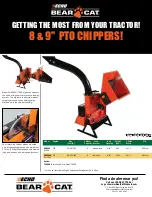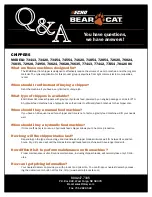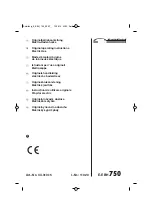
3
particles that may have entered the exchanger. Then reconnect and rinse in the normal wort flow
direction. A couple minutes each way is sufficient. Remove the adapter fittings if used and scrub with a
soft brush, taking care to remove all sealing tape if used. A ½ to 1 hour soak in hot PBW is recommended
after this rinsing to remove any stubborn deposits and proteins. Rinse thoroughly, then soak the unit in a
sanitizing solution as previously described. Drain and allow to drip-dry. Do not store the unit full of
sanitizer due to potential galvanic corrosion issues. An alternate method to sanitize the unit is to immerse
it in boiling water for 10-15 minutes, which will completely sterilize it.
Storage: Store the Therminator
TM
as shown in Fig. 3a with the ends open and facing
down. This will allow any remaining water to drain to the bottom and evaporate
through the openings which will prevent mildew. It is normal for there to be a bit of
trapped water at the fittings, but this will evaporate in a few days.
Caution:
StarSan users – this is an acid based sanitizer, and although it will not
harm copper for short periods, it will harm the unit if exposed for extended periods.
Prior to storage rinse the unit thoroughly (both wort and cooling water sides) with
hot tap water to remove the residual sanitizer from the unit.
Periodic maintenance: Over time, salts from your cooling water and wort can
accumulate on the surfaces of the exchanger lowering the efficiency and increasing
the chances for contamination. After approximately 6 uses or every 6 months, soak the unit in a mild (5%)
food grade citric or phosphoric acid solution for ½ to 1 hour, filling and draining periodically to ensure
fresh solution reaches the interior of the exchanger. Rinse thoroughly, drain, and drip-dry. If you are
using StarSan (an acid sanitizer) this is not necessary.
Installation & Operation:
For the exchanger to perform properly, it is critical that all surfaces of the exchanger be continuously
flooded with cooling water and wort. If air is trapped in the unit, not only will the exchanger performance
drastically drop, but also you will be oxidizing your wort. It is also permissible to operate the unit with the
fittings facing vertically, but the wort inlet should be facing downward. While other installation
configurations may work, thee recommended positions allow air to naturally purge from the unit. If you
see bubbles of air in your wort hoses, it is likely due to loose fittings or hose clamps allowing air to enter
the system. Tighten as needed.
If you wish to control the cooling water flow rate through the unit, it is permissible to install a valve on the
inlet
side of the exchanger. Or simply control the flow using the garden hose bib.
It is highly recommended that you install a filter in front of the chiller (stainless scouring pad, screen type
filters, Y-strainer or similar pre-filter) to ensure particulate matter remains in the brew pot and does not
plug the hoses, pump or exchanger. When boiling is finished, start a strong whirlpool with your stir
paddle by stirring clockwise vigorously. Cover and let it sit for 10-15 min to settle the hops & trub in the
center of the brew pot. Then begin draining and chilling the
wort. This will also enhance the flavor and clarity of your
finished beer.
For gravity flow chilling:
This procedure is used for systems where elevation (gravity) is
utilized to move the wort from the boil kettle to the fermentor.
Install the exchanger as shown in Fig. 4 ensuring that the
exchanger is laid on its side and is lower than the brew pot and
at the same level as the bottom of the fermentor (or below it). If
it is raised higher, the wort will quickly drain from the exchanger
exposing a portion of the plates and lowering the capacity of the
unit. Using a hose “pinch-valve” (shown in Fig. 4)
after
the
exchanger is a good way to control the flow rate of wort through
Fig. 4
Fig. 3a

























